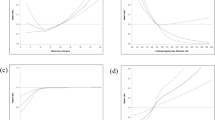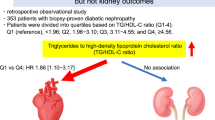Abstract
Background
A high atherogenic index of plasma (AIP) is associated with increased cardiovascular risk and higher serum uric acid levels, but whether AIP is a strong risk factor for developing subclinical renal damage (SRD) is unknown. This study aimed to explore the effect of AIP variations on the prevalence of SRD in a 12-year follow-up study.
Methods
(1) The cross-sectional study enrolled 2485 participants from the Hanzhong cohort in 2017; (2) A total of 202 participants were included in the small longitudinal cohort from 2005 to 2017. Longitudinal analysis was used to determine whether an elevated AIP predicts the development of SRD.
Results
In the cross-sectional analysis, the AIP level was correlated with the estimated glomerular filtration rate (eGFR) and urinary albumin-to-creatine ratio (uACR) (P < 0.05). The age-adjusted odds ratio (OR) for prevalent SRD in men in the high AIP group was 1.924 (1.355–2.732) (P < 0.001), while in women, the OR was 1.616 (1.049–2.490) (P = 0.030) in the high AIP group. In the longitudinal analysis, significantly higher uACR levels were found in participants with normal AIP at baseline and elevated AIP in 2013 (P < 0.05). The adjusted OR for prevalent SRD in the incident AIP group was 4.741 (1.668–13.472) (P = 0.003) compared with the control group.
Conclusions
Our study indicates that elevated AIP increased the risk of developing SRD and was associated with uACR and eGFR. As a simple marker of CVD risk, AIP may emerge as a novel and reliable indicator of SRD.
This is a preview of subscription content, access via your institution
Access options
Subscribe to this journal
Receive 12 print issues and online access
$259.00 per year
only $21.58 per issue
Buy this article
- Purchase on Springer Link
- Instant access to full article PDF
Prices may be subject to local taxes which are calculated during checkout



Similar content being viewed by others
References
Niroumand S, Khajedaluee M, Khadem-Rezaiyan M, Abrishami M, Juya M, Khodaee G, et al. Atherogenic Index of Plasma (AIP): a marker of cardiovascular disease. Med J Islam Repub Iran. 2015;29:240.
Chang Y, Li Y, Guo X, Dai D, Sun Y. The association of ideal cardiovascular health and atherogenic index of plasma in rural population: a cross-sectional study from Northeast China. Int J Environ Res Public Health. 2016;13:1027
Daniels LB, Laughlin GA, Sarno MJ, Bettencourt R, Wolfert RL, Barrett-Connor E. Lipoprotein-associated phospholipase A2 is an independent predictor of incident coronary heart disease in an apparently healthy older population: the Rancho Bernardo Study. J Am Coll Cardiol. 2008;51:913–9.
Dobiasova M, Frohlich J. The new atherogenic plasma index reflects the triglyceride and HDL-cholesterol ratio, the lipoprotein particle size and the cholesterol esterification rate: changes during lipanor therapy. Vnitr̆ní lékar̆ství. 2000;46:152–6.
Dobiasova M, Urbanova Z, Samanek M. Relations between particle size of HDL and LDL lipoproteins and cholesterol esterification rate. Physiol Res. 2005;54:159–65.
Shen S, Lu Y, Qi H, Li F, Shen Z, Wu L, et al. Association between ideal cardiovascular health and the atherogenic index of plasma. Medicine. 2016;95:e3866.
Raslova K, Dobiasova M, Hubacek JA, Bencova D, Sivakova D, Dankova Z, et al. Association of metabolic and genetic factors with cholesterol esterification rate in HDL plasma and atherogenic index of plasma in a 40 years old Slovak population. Physiol Res. 2011;60:785–95.
Akbas EM, Timuroglu A, Ozcicek A, Ozcicek F, Demirtas L, Gungor A, et al. Association of uric acid, atherogenic index of plasma and albuminuria in diabetes mellitus. Int J Clin Exp Med. 2014;7:5737–43.
Cho DR, Lee SH. Effects of virtual reality immersive training with computerized cognitive training on cognitive function and activities of daily living performance in patients with acute stage stroke: A preliminary randomized controlled trial. Medicine. 2019;98:e14752.
Ninomiya T, Kiyohara Y, Kubo M, Tanizaki Y, Doi Y, Okubo K, et al. Chronic kidney disease and cardiovascular disease in a general Japanese population: the Hisayama Study. Kidney Int. 2005;68:228–36.
Tanaka K, Watanabe T, Takeuchi A, Ohashi Y, Nitta K, Akizawa T, et al. Cardiovascular events and death in Japanese patients with chronic kidney disease. Kidney Int. 2017;91:227–34.
Coresh J, Selvin E, Stevens LA, Manzi J, Kusek JW, Eggers P, et al. Prevalence of chronic kidney disease in the United States. JAMA. 2007;298:2038–47.
Gonsalez SR, Ferrao FM, Souza AM, Lowe J, Morcillo L. Inappropriate activity of local renin-angiotensin-aldosterone system during high salt intake: impact on the cardio-renal axis. J Bras Nephrol. 2018;40:170–8.
Zeisberg M, Koziolek MJ. Cardio-renal axis: relationship of heart failure and renal insufficiency as comorbidities. Internist. 2018;59:420–7.
Expert Panel on Detection E, Treatment of High Blood Cholesterol in A. Executive Summary of The Third Report of The National Cholesterol Education Program (NCEP) expert panel on detection, evaluation, and treatment of high blood cholesterol in adults (Adult Treatment Panel III). JAMA. 2001;285:2486–97.
Bourne GH. Letter: television film: “primates”. JAMA. 1975;232:1330.
Aitbaev KA, Murkamilov IT, Fomin VV. Kardiologiia. 2019;59:79–87.
Kanda E, Ai M, Okazaki M, Yoshida M, Maeda Y. Association of high-density lipoprotein subclasses with chronic kidney disease progression, atherosclerosis, and Klotho. PLoS ONE. 2016;11:e0166459.
Chu C, Dai Y, Mu J, Yang R, Wang M, Yang J, et al. Associations of risk factors in childhood with arterial stiffness 26 years later: the Hanzhong adolescent hypertension cohort. J Hypertens. 2017;35(Suppl 1):S10–S15.
Zheng W, Mu J, Chu C, Hu J, Yan Y, Ma Q, et al. Association of blood pressure trajectories in early life with subclinical renal damage in middle age. J Am Soc Nephrol. 2018;29:2835–46.
Ma YC, Zuo L, Chen JH, Luo Q, Yu XQ, Li Y, et al. Modified glomerular filtration rate estimating equation for Chinese patients with chronic kidney disease. J Am Soc Nephrol. 2006;17:2937–44.
Yano Y, Fujimoto S, Asahi K, Watanabe T. Prevalence of chronic kidney disease in China. Lancet. 2012;380:213–4. author reply 214-216
Mule G, Calcaterra I, Costanzo M, Geraci G, Guarino L, Foraci AC, et al. Relationship between short-term blood pressure variability and subclinical renal damage in essential hypertensive patients. J Clin Hypertens. 2015;17:473–80.
Leoncini G, Viazzi F, Conti N, Baratto E, Tomolillo C, Bezante GP, et al. Renal and cardiac abnormalities in primary hypertension. J Hypertens. 2009;27:1064–73.
Chang Y, Li Y, Guo X, Guo L, Sun Y. Atherogenic index of plasma predicts hyperuricemia in rural population: a cross-sectional study from Northeast China. Int J Environ Res Public Health. 2016;13:879
Chen H, Chen L, Liu D, Chen DQ, Vaziri ND, Yu XY, et al. Combined clinical phenotype and lipidomic analysis reveals the impact of chronic kidney disease on lipid metabolism. J Proteome Res. 2017;16:1566–78.
Lanktree MB, Theriault S, Walsh M, Pare G. HDL cholesterol, LDL cholesterol, and triglycerides as risk factors for CKD: a mendelian randomization study. Am J Kidney Dis. 2018;71:166–72.
Maheshwari N, Ansari MR, Darshana MS, Lal K, Ahmed K. Pattern of lipid profile in patients on maintenance hemodialysis. Saudi J Kidney Dis Transpl. 2010;21:565–70.
Kopman AF. Clinical, electrical and mechanical correlations during recovery from neuromuscular blockade with vecuronium. Can J Anaesth. 1990;37:711.
Zhao H, Jiang YF, Zhou XC, Yao L, Chen J, Wang D, et al. An effective indicator in predicting cardiovascular events: urine albumin to creatinine ratio. Eur Rev Med Pharm Sci. 2017;21:3290–5.
Moura Rdo S, Vasconcelos DF, Freitas E, Moura FJ, Rosa TT, Veiga JP, et al. CRP, log TG/HDLc and metabolic syndrome are associated with microalbuminuria in hypertension. Arq Bras Cardiol. 2014;102:54–9.
Wen J, Chen Y, Huang Y, Lu Y, Liu X, Zhou H, et al. Association of the TG/HDL-C and Non-HDL-C/HDL-C ratios with chronic kidney disease in an adult chinese population. Kidney Blood Press Res. 2017;42:1141–54.
Rahman M, Yang W, Akkina S, Alper A, Anderson AH, Appel LJ, et al. Relation of serum lipids and lipoproteins with progression of CKD: the CRIC study. Clin J Am Soc Nephrol. 2014;9:1190–8.
Kalantar-Zadeh K, Stenvinkel P, Pillon L, Kopple JD. Inflammation and nutrition in renal insufficiency. Adv Ren Replace Ther. 2003;10:155–69.
Kalantar-Zadeh K, Kopple JD. Relative contributions of nutrition and inflammation to clinical outcome in dialysis patients. Am J Kidney Dis. 2001;38:1343–50.
Acknowledgements
We are indebted to the participants in the study for their outstanding commitment and cooperation. This work was supported by the National Natural Science Foundation of China (No. 81570381 (J-JM), No. 81600327 (YW) and No. 81700368 (CC)), the Clinical Research Award of the First Affiliated Hospital of Xi’an Jiaotong University of China (No. XJTU1AF-CRF-2017-021 (YW)), grants 2017YFC1307604 and 2016YFC1300104 from the Major Chronic Non-communicable Disease Prevention and Control Research Key Project of the Ministry of Science and Technology of the People’s Republic of China, and grant 2017ZDXM-SF-107 from the Key Research Project of Shaanxi Province. The sponsors and funding organizations had no role in the design or conduct of this research.
Author information
Authors and Affiliations
Corresponding author
Ethics declarations
Conflict of interest
The authors declare that they have no conflict of interest.
Additional information
Publisher’s note Springer Nature remains neutral with regard to jurisdictional claims in published maps and institutional affiliations.
Registration number for clinical trials: NCT02734472
Rights and permissions
About this article
Cite this article
Yuan, Y., Hu, JW., Wang, Y. et al. Association between atherogenic index of plasma and subclinical renal damage over a 12-year follow-up: Hanzhong adolescent hypertension study. Eur J Clin Nutr 74, 278–284 (2020). https://doi.org/10.1038/s41430-019-0530-x
Received:
Revised:
Accepted:
Published:
Issue Date:
DOI: https://doi.org/10.1038/s41430-019-0530-x
This article is cited by
-
Association between the atherogenic index of plasma and major adverse cardiovascular events among non-diabetic hypertensive older adults
Lipids in Health and Disease (2022)



